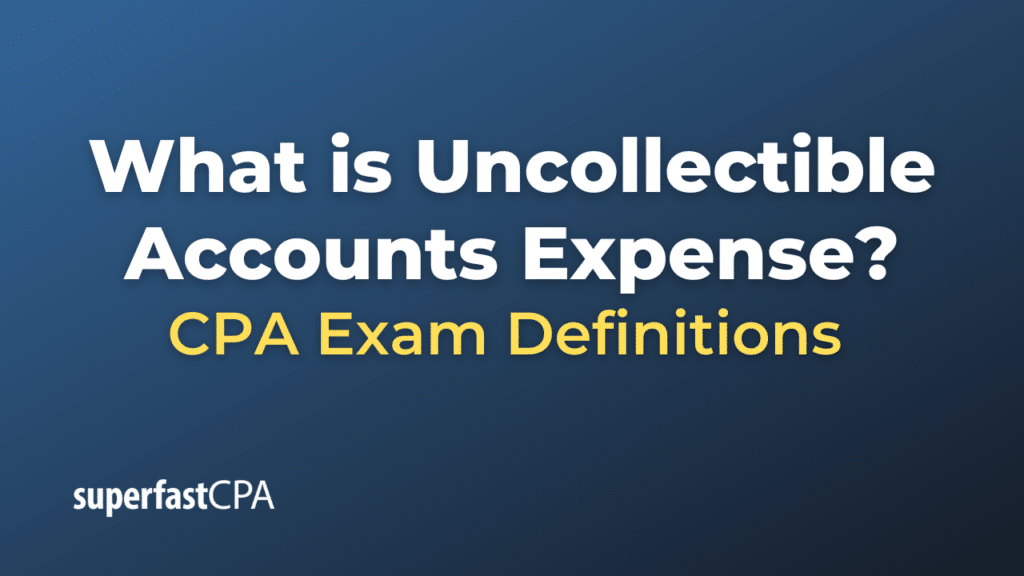Uncollectible Accounts Expense
Uncollectible Accounts Expense, also known as Bad Debt Expense or Doubtful Accounts Expense, is an expense account representing the estimated amount of accounts receivable that a business expects it will not be able to collect. Essentially, it’s an acknowledgment that not all customers who owe money to the company will pay their debts. This expense is reported on the income statement and is usually estimated using historical data, percentages of sales, or an aging analysis of accounts receivable.
Importance:
- Financial Reporting: Properly estimating and accounting for uncollectible accounts is essential for the accuracy of financial statements. It allows the company to present a more realistic picture of its financial position.
- Matching Principle: This accounting concept aligns with the matching principle, which states that revenues and the associated expenses should be recognized in the same accounting period. The Uncollectible Accounts Expense matches the cost of bad debts to the revenue that was recognized but will not be collected.
- Cash Flow Management : Understanding potential uncollectible accounts can also help a business manage its cash flows more effectively, as it gives an idea of how much of the accounts receivable is actually likely to be converted into cash.
- Risk Assessment: For investors and creditors, a high level of Uncollectible Accounts Expense relative to sales may indicate financial instability or risk associated with a company’s operations.
Methods to Estimate Uncollectible Accounts:
- Percentage of Sales Method: This method applies a fixed percentage to the total credit sales for the period to estimate bad debts.
- Aging of Accounts Receivable Method: This method categorizes accounts receivable based on how long they have been outstanding and applies a higher percentage of uncollectibility to older accounts.
Example of Uncollectible Accounts Expense
Let’s consider a fictional company, “TechGuru,” that sells electronic gadgets on credit terms to various customers. Here’s how TechGuru could handle Uncollectible Accounts Expense using the “Percentage of Sales Method.”
Background:
- TechGuru has credit sales totaling $1,000,000 for the fiscal year.
- Based on past experience, the company estimates that about 1% of its credit sales will end up being uncollectible.
Estimating Uncollectible Accounts Expense:
Using the Percentage of Sales Method, TechGuru would calculate the Uncollectible Accounts Expense as follows:
Uncollectible Accounts Expense = Credit Sales × Estimated Bad Debt Percentage
Uncollectible Accounts Expense = $1,000,000 × 0.01 = $10,000
Accounting Entries:
TechGuru would make the following accounting entries to record this estimated expense:
- Debit Uncollectible Accounts Expense for $10,000: This increases the expense on the income statement, which in turn decreases net income.Journal Entry:
- Debit Uncollectible Accounts Expense: $10,000
- Credit Allowance for Doubtful Accounts for $10,000: This is a contra-asset account that reduces the accounts receivable on the balance sheet to its estimated net realizable value.Journal Entry:
- Credit Allowance for Doubtful Accounts: $10,000
Financial Statement Impact:
- Income Statement: A bad debt expense of $10,000 would be recorded, reducing the net income for the year.
- Balance Sheet: Accounts Receivable would still be shown at $1,000,000, but it would be offset by the Allowance for Doubtful Accounts with a credit balance of $10,000. Thus, the net realizable value of accounts receivable would be $990,000.
By taking these steps, TechGuru adheres to the generally accepted accounting principles (GAAP), specifically the matching principle, and provides a more accurate picture of its financial health to investors, creditors, and other stakeholders.













